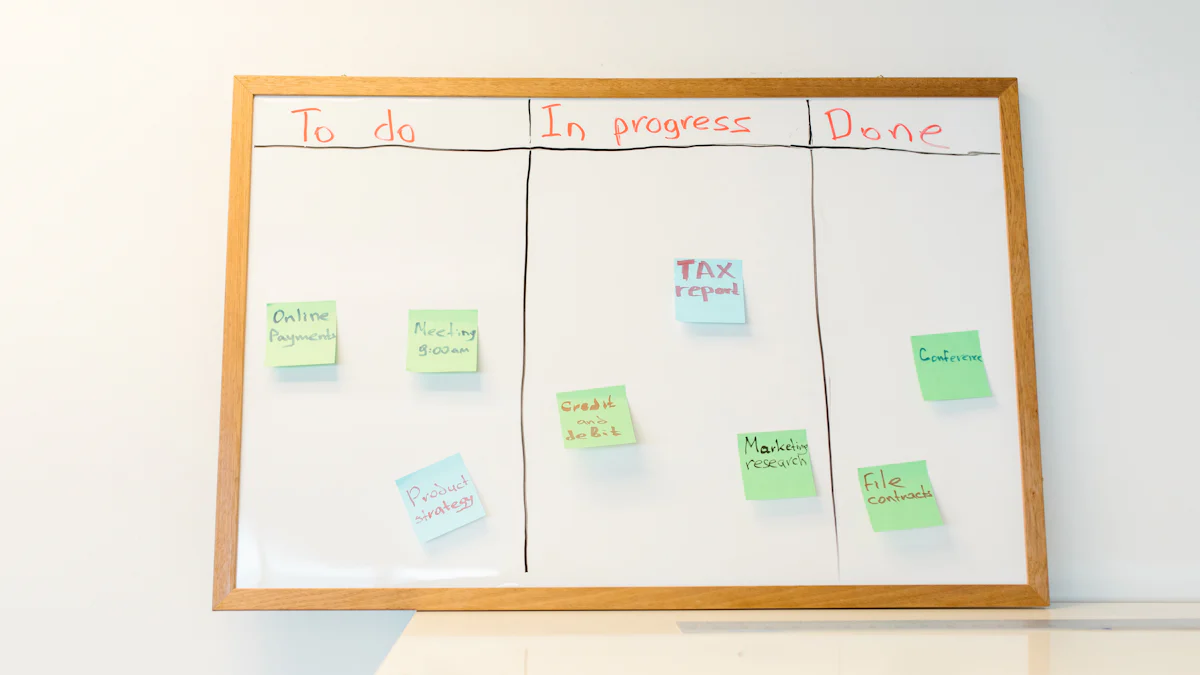How to Prioritize Kanban Tasks

Effective Task Management with Kanban Prioritization
Prioritizing tasks is a crucial aspect of effective task management and can greatly enhance productivity. When it comes to managing tasks on a kanban board, using a prioritization matrix can be incredibly helpful. This matrix allows you to categorize tasks based on their importance and urgency, providing you with a clear understanding of which tasks should take precedence. In this step-by-step guide, we will explore how project managers, team leaders, and professionals can leverage the power of a prioritization matrix to improve their task management skills. By following these techniques, you can streamline your workflow, meet deadlines more efficiently, and achieve better results in your projects.
Step 1: Identify and List Tasks
To effectively prioritize tasks on your kanban board, the first step is to identify and list all the tasks that need to be prioritized. Here's how you can go about it:
Start by identifying and listing all the tasks in your kanban board.
Take a thorough look at your kanban board and make a note of all the tasks that are currently in progress or upcoming. It's important to include both ongoing tasks as well as any new tasks that may have come up. By capturing all the tasks, you ensure that nothing gets overlooked during the prioritization process.
Ensure that all tasks are clearly defined and have a specific goal or outcome.
As you list down the tasks, it's crucial to ensure that each task is clearly defined with a specific goal or outcome in mind. This clarity helps in understanding the purpose of each task and its relevance to the overall project or goals. Clearly defined tasks also make it easier for team members to understand their responsibilities and deliverables.
Include both ongoing and new tasks in your list.
When creating your task list, don't forget to include both ongoing tasks that are already in progress as well as any new tasks that have been identified. This comprehensive approach ensures that you have a complete view of all the work that needs to be prioritized. Ongoing tasks may require adjustments based on changing priorities, while new tasks can be evaluated alongside existing ones for proper prioritization.
By taking these steps to identify and list all the tasks on your kanban board, you set yourself up for effective prioritization and improved task management.
Step 2: Assign Importance and Urgency Ratings
Once you have identified and listed all the tasks on your kanban board, the next step is to assign importance and urgency ratings to each task. This helps in determining their priority level within the project. Here's how you can go about it:
Assign importance and urgency ratings to each task.
Importance refers to the significance of a task in relation to the overall project or goals. Consider factors such as impact on project success, alignment with strategic objectives, or client requirements when assigning importance ratings. Urgency, on the other hand, indicates the time sensitivity or deadline associated with a task. Evaluate deadlines, dependencies, and time constraints to determine urgency ratings.
Use a scale, such as high, medium, and low, to rate the importance and urgency of each task.
To effectively prioritize tasks based on their importance and urgency, it's helpful to use a rating scale. A common approach is to use a scale of high, medium, and low for both importance and urgency. This allows for clear differentiation between tasks and makes it easier to identify which tasks require immediate attention.
By assigning importance and urgency ratings to each task on your kanban board, you gain valuable insights into their relative priority levels. This information serves as a foundation for making informed decisions about resource allocation and task sequencing in order to maximize productivity and achieve project success.
Step 3: Plot Tasks on the Prioritization Matrix
Once you have assigned importance and urgency ratings to each task, the next step is to create a prioritization matrix and plot the tasks based on their ratings. This visual representation helps in identifying which tasks require immediate attention. Here's how you can do it:
Create a prioritization matrix to plot the tasks based on their importance and urgency.
To create a prioritization matrix, start by drawing a matrix with four quadrants: high importance and high urgency, high importance and low urgency, low importance and high urgency, and low importance and low urgency. These quadrants represent different combinations of importance and urgency ratings.
Place each task in the corresponding quadrant based on its importance and urgency ratings.
Take each task from your list and place it in the appropriate quadrant of the prioritization matrix based on its assigned importance and urgency ratings. Tasks with both high importance and high urgency should be placed in the top-left quadrant, indicating that they require immediate attention. Tasks with high importance but lower urgency can be placed in the top-right quadrant, while tasks with lower importance but higher urgency can be placed in the bottom-left quadrant. Finally, tasks with both low importance and low urgency can be placed in the bottom-right quadrant.
This visual representation helps in identifying the tasks that require immediate attention.
By plotting tasks on the prioritization matrix, you gain a clear visual representation of their relative priority levels. This allows you to quickly identify which tasks need to be addressed first based on their placement in the matrix. The top-left quadrant contains tasks that are both important and urgent, making them top priorities for your team. This visual approach helps streamline decision-making processes, enabling you to focus your efforts where they matter most.
Creating a prioritization matrix provides a powerful tool for managing your kanban board effectively. It ensures that you allocate resources appropriately by addressing critical tasks promptly while still considering those of lesser priority.
Step 4: Focus on High Importance and High Urgency Tasks
Once you have plotted the tasks on the prioritization matrix, it's time to focus on the high importance and high urgency quadrant. These tasks should be given top priority as they have both significant importance and urgent deadlines. Here's how you can effectively prioritize and manage these tasks:
Prioritize tasks in the high importance and high urgency quadrant.
Tasks that fall into the high importance and high urgency quadrant require immediate attention. These tasks are critical to the success of your project or goals, and their timely completion is crucial. By focusing on these tasks first, you ensure that you are addressing the most important and time-sensitive aspects of your work.
Allocate resources and assign team members to work on these tasks.
To effectively manage high importance and high urgency tasks, allocate appropriate resources based on their complexity and requirements. Assign team members who have the necessary skills and expertise to handle these tasks efficiently. By ensuring that you have the right people working on these critical tasks, you increase the likelihood of meeting deadlines and achieving desired outcomes.
Ensure effective communication and collaboration to meet deadlines and achieve desired outcomes.
Effective communication is key when working on high importance and high urgency tasks. Keep all stakeholders informed about progress, challenges, and any changes in priorities. Foster collaboration among team members by encouraging open dialogue, sharing knowledge, and leveraging each other's strengths. Regularly communicate updates, provide support where needed, and address any roadblocks promptly to ensure that deadlines are met successfully.
By focusing on high importance and high urgency tasks in a systematic manner, you can effectively manage your workload while ensuring that critical objectives are met within specified timelines. This approach helps maintain momentum in your projects while keeping everyone aligned towards achieving desired outcomes.
Step 5: Regularly Review and Update the Prioritization Matrix
To ensure that your task prioritization remains effective, it is important to regularly review and update the prioritization matrix. This allows you to adapt to changing priorities and keep your projects on track. Here's how you can do it:
Regularly review and update the prioritization matrix to adapt to changing priorities.
As new tasks arise or priorities shift, it is essential to revisit the prioritization matrix and make necessary adjustments. This ensures that your task list reflects the current state of your project. By regularly reviewing the matrix, you can identify any tasks that may have changed in importance or urgency and prioritize them accordingly.
Reassess the importance and urgency ratings of tasks based on the current project status.
During the review process, take the time to reassess the importance and urgency ratings of each task based on the current project status. Factors such as changes in project goals, deadlines, or resource availability may influence these ratings. By reevaluating these ratings, you can ensure that your task prioritization aligns with the evolving needs of your project.
Maintain open communication with the team to ensure everyone is aware of the updated priorities.
Effective communication is crucial when updating priorities based on changes in the prioritization matrix. Keep your team members informed about any updates or adjustments made to task priorities. This helps maintain alignment within the team and ensures that everyone understands their roles and responsibilities in light of these changes.
By regularly reviewing and updating the prioritization matrix, you can adapt to shifting priorities and keep your projects on track. This iterative approach allows for flexibility while maintaining focus on high-priority tasks. It also promotes transparency within your team, fostering a collaborative environment where everyone is aware of updated priorities and can work together towards achieving project success.
Enhance Task Management with Kanban Prioritization
Prioritizing kanban tasks using a prioritization matrix is a powerful technique that can greatly enhance task management and boost productivity. By categorizing tasks based on their importance and urgency, project managers and team leaders are able to allocate resources effectively and ensure that the most critical tasks receive the attention they deserve. Regularly reviewing and updating the prioritization matrix allows for adaptability in response to changing priorities, ensuring that tasks align with project goals and deadlines. By implementing these strategies, you can streamline your workflow, improve collaboration, and achieve better results in your projects.
See Also
Implementing Kanban Boards for Efficient Project Management
Utilizing Kanban Boards for Optimal Project Management
Measuring WIP in Kanban through Cumulative Flow Diagrams
Leveraging Kanban Boards for Streamlined Workflow Management
Comprehending Kanban Boards: Enhancing Productivity through Guidance

